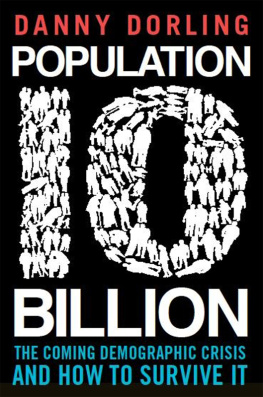National Research Council - BEYOND SIX BILLION: Forecasting the World’s Population
Here you can read online National Research Council - BEYOND SIX BILLION: Forecasting the World’s Population full text of the book (entire story) in english for free. Download pdf and epub, get meaning, cover and reviews about this ebook. year: 2000, publisher: NATIONAL ACADEMY PRESS, genre: Politics. Description of the work, (preface) as well as reviews are available. Best literature library LitArk.com created for fans of good reading and offers a wide selection of genres:
Romance novel
Science fiction
Adventure
Detective
Science
History
Home and family
Prose
Art
Politics
Computer
Non-fiction
Religion
Business
Children
Humor
Choose a favorite category and find really read worthwhile books. Enjoy immersion in the world of imagination, feel the emotions of the characters or learn something new for yourself, make an fascinating discovery.
- Book:BEYOND SIX BILLION: Forecasting the World’s Population
- Author:
- Publisher:NATIONAL ACADEMY PRESS
- Genre:
- Year:2000
- Rating:4 / 5
- Favourites:Add to favourites
- Your mark:
- 80
- 1
- 2
- 3
- 4
- 5
BEYOND SIX BILLION: Forecasting the World’s Population: summary, description and annotation
We offer to read an annotation, description, summary or preface (depends on what the author of the book "BEYOND SIX BILLION: Forecasting the World’s Population" wrote himself). If you haven't found the necessary information about the book — write in the comments, we will try to find it.
National Research Council: author's other books
Who wrote BEYOND SIX BILLION: Forecasting the World’s Population? Find out the surname, the name of the author of the book and a list of all author's works by series.
BEYOND SIX BILLION: Forecasting the World’s Population — read online for free the complete book (whole text) full work
Below is the text of the book, divided by pages. System saving the place of the last page read, allows you to conveniently read the book "BEYOND SIX BILLION: Forecasting the World’s Population" online for free, without having to search again every time where you left off. Put a bookmark, and you can go to the page where you finished reading at any time.
Font size:
Interval:
Bookmark:
BEYOND SIX BILLION
Forecasting the Worlds Population
Panel on Population Projections
John Bongaarts and Rodolfo A. Bulatao, Editors
Committee on Population
Commission on Behavioral and Social Sciences and Education
National Research Council
NATIONAL ACADEMY PRESS
Washington, D.C.
NATIONAL ACADEMY PRESS
2101 Constitution Ave., N.W.
Washington, D.C.20418
NOTICE: The project that is the subject of this report was approved by the Governing Board of the National Research Council, whose members are drawn from the councils of the National Academy of Sciences, the National Academy of Engineering, and the Institute of Medicine. The members of the panel responsible for the report were chosen for their special competences and with regard for appropriate balance.
This study was supported by grants to the National Academy of Sciences from the Andrew W. Mellon Foundation, the David and Lucile Packard Foundation, the Rockefeller Foundation, the United States Agency for International Development, and the William and Flora Hewlett Foundation. Any opinions, findings, conclusions, or recommendations expressed in this publication are those of the authors and do not necessarily reflect the views of the organizations or agencies that provided support for the project.
Suggested citation: National Research Council (2000) Beyond Six Billion: Forecasting the Worlds Population. Panel on Population Projections. John Bongaarts and Rodolfo A. Bulatao, eds. Committee on Population, Commission on Behavioral and Social Sciences and Education. Washington, D.C.: National Academy Press.
Library of Congress Cataloging-in-Publication Data
National Research Council (U.S.)
Beyond six billion: forecasting the worlds population / Panel on Population Projections, Committee on Population, Commission on Behavioral and Social Sciences and Education, National Research Council; John Bongaarts and Rodolfo A. Bulatao, editors.
p. cm.
ISBN 0-309-20282-5 mobi ISBN
ISBN 0-309-06990-4 (hard)
1. Population forecasting. I. Title: Beyond 6 billion. II. Bongaarts, John, 1945- III. Bulatao, Rodolfo A., 1944- IV. Title.
HB849.53 .N385 2000
304.620112--dc21
00-009983
Additional copies of this report are available from National Academy Press, 2101 Constitution Avenue, N.W., Lockbox 285, Washington, D.C. 20055; (800) 624-6242 or (202) 334-3313 (in the Washington metropolitan area); Internet,
http://www.nap.edu
Cover: Hands, copyright The Stock Market/Don Mason, 2000, and view of the earth from space, NASA.
National Academy of Sciences
National Academy of Engineering
Institute of Medicine
National Research Council
The National Academy of Sciences is a private, nonprofit, self-perpetuating society of distinguished scholars engaged in scientific and engineering research, dedicated to the furtherance of science and technology and to their use for the general welfare. Upon the authority of the charter granted to it by the Congress in 1863, the Academy has a mandate that requires it to advise the federal government on scientific and technical matters. Dr. Bruce M. Alberts is president of the National Academy of Sciences.
The National Academy of Engineering was established in 1964, under the charter of the National Academy of Sciences, as a parallel organization of outstanding engineers. It is autonomous in its administration and in the selection of its members, sharing with the National Academy of Sciences the responsibility for advising the federal government. The National Academy of Engineering also sponsors engineering programs aimed at meeting national needs, encourages education and research, and recognizes the superior achievements of engineers. Dr. William A. Wulf is president of the National Academy of Engineering.
The Institute of Medicine was established in 1970 by the National Academy of Sciences to secure the services of eminent members of appropriate professions in the examination of policy matters pertaining to the health of the public. The Institute acts under the responsibility given to the National Academy of Sciences by its congressional charter to be an adviser to the federal government and, upon its own initiative, to identify issues of medical care, research, and education. Dr. Kenneth I. Shine is president of the Institute of Medicine.
The National Research Council was organized by the National Academy of Sciences in 1916 to associate the broad community of science and technology with the Academys purposes of furthering knowledge and advising the federal government. Functioning in accordance with general policies determined by the Academy, the Council has become the principal operating agency of both the National Academy of Sciences and the National Academy of Engineering in providing services to the government, the public, and the scientific and engineering communities. The Council is administered jointly by both Academies and the Institute of Medicine. Dr. Bruce M. Alberts and Dr. William A. Wulf are chairman and vice chairman, respectively, of the National Research Council.
JOHN BONGAARTS
(Chair),
The Population Council, New York City
JUHA M. ALHO,
Department of Statistics, University of Joensuu, Finland
ALAKA M. BASU,
Division of Nutritional Sciences, Cornell University
JOHN G. CLELAND,
Centre for Population Studies, London School of Hygiene and Tropical Medicine
JOEL E. COHEN,
Laboratory of Populations, Rockefeller University and Columbia University
KENNETH H. HILL,
Department of Population and Family Health Services, Johns Hopkins University
NICO KEILMAN,
Department of Economics, University of Oslo, Norway
RONALD D. LEE,
Department of Demography, University of California, Berkeley
MASSIMO LIVI-BACCI,
Department of Statistics, University of Florence, Italy
DOUGLAS S. MASSEY,
Department of Sociology, University of Pennsylvania
S. PHILIP MORGAN,
Department of Sociology, Duke University
ALBERTO PALLONI,
Department of Sociology, University of Wisconsin, Madison
ANNE R. PEBLEY,
School of Public Health and Department of Sociology, University of California, Los Angeles
SHARON STANTON RUSSELL,
Center for International Studies, Massachusetts Institute of Technology
WARREN C. SANDERSON,
Department of Economics, State University of New York, Stony Brook
THOMAS SCHELLING,
School of Public Affairs, University of Maryland, College Park
MICHAEL TEITELBAUM,
Alfred P. Sloan Foundation, New York City
JAMES W. VAUPEL,
Max Planck Institute for Demographic Research, Rostock, Germany
RODOLFO A. BULATAO,
Study Director
HOLLY E. REED,
Research Associate
ELIZABETH A. WALLACE,
Project Assistant
JANE MENKEN
(Chair),
Institute of Behavioral Sciences, University of Colorado, Boulder
CAROLINE H. BLEDSOE,
Department of Anthropology, Northwestern University
JOHN BONGAARTS,
The Population Council, New York City
ELLEN BRENNAN-GALVIN,
Population Division, United Nations, New York City
JOHN N. HOBCRAFT,
Population Investigation Committee, London School of Economics
F. THOMAS JUSTER,
Institute for Social Research, University of Michigan, Ann Arbor
Font size:
Interval:
Bookmark:
Similar books «BEYOND SIX BILLION: Forecasting the World’s Population»
Look at similar books to BEYOND SIX BILLION: Forecasting the World’s Population. We have selected literature similar in name and meaning in the hope of providing readers with more options to find new, interesting, not yet read works.
Discussion, reviews of the book BEYOND SIX BILLION: Forecasting the World’s Population and just readers' own opinions. Leave your comments, write what you think about the work, its meaning or the main characters. Specify what exactly you liked and what you didn't like, and why you think so.










